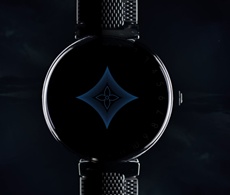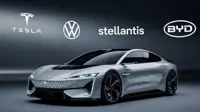Louis Vuitton embraces technology: smart watch just the start
12 Jul 2017
Fashion brand Louis Vuitton, on Tuesday became the latest to join the smart wearables bandwagon, introducing its first smartwatch, the Tambour Horizon - the newest addition to the Tambour watch family, the signature timepiece the company debuted 15 years ago.
 With this, experts say Vuitton, best known for its suitcases, is aiming to directly take on wearables market leader Apple Inc. The Tambour Horizon starts at $2,450, about eight times the price of an entry-level Apple Watch and significantly more than many other connected devices from European watch and fashion brands, as well as more pedestrian gadgets from Samsung Electronics Co.
With this, experts say Vuitton, best known for its suitcases, is aiming to directly take on wearables market leader Apple Inc. The Tambour Horizon starts at $2,450, about eight times the price of an entry-level Apple Watch and significantly more than many other connected devices from European watch and fashion brands, as well as more pedestrian gadgets from Samsung Electronics Co.
It follows Tag Heuer's Connected watch, the Apple Watch Hermès and Michael Kors's Access line (in collaboration with Fossil).
Within two years, Apple has become the world's second-bestselling watch brand, outranked only by Rolex, disrupting sales of low-end makers and convincing Vuitton that it needs to offer alternatives or risk falling behind.
While low-end Swiss manufacturers such as Swatch Group AG's namesake brand have introduced intelligent timepieces, exclusive makers like Rolex and Patek Philippe have largely steered clear for fear of sullying their image.
And of course there are the nay-sayers who feel devices like smart watches are seeking to solve problems that aren't actually there.
According to Michael Burke, chief executive of Louis Vuitton, this is an effort to combat the fact that when it comes to wearable technology, ''there's a lot of ugliness out there''.
''For us,'' he said, ''the aesthetic is non-negotiable.''
The watch is only the beginning of Vuitton's plans for merging style and technology. Vuitton has designs on connecting many of their products.
''Look, the internet of things is really only going to get bigger,'' Burke said. ''You can sit on the sidelines and watch, or dive in and participate and try to influence where things go. We're diving in.''
Made in conjunction with Google and Qualcomm Technology, with a case made in Switzerland, the Tambour Horizon does what most smartwatches do - it alerts you to your email and texts, counts your steps, has lots of apps - though it does not contain a heart monitor and is not meant to replace the phone.
It works with both Apple and Android devices and has a battery life of about a day. Like the Apple watch, it charges when you click on to a magnetic pad, connects to your phone via Bluetooth and also works with Wi-Fi. It comes in three finishes (polished steel, brushed steel and full black), and it has 30 different straps for men and 30 for women, which (according to The New York Times) snap on and off with a satisfying ease.
The NYT goes deeper into the specs. The watch face (which can be customised like a handbag in myriad ways - with various dials, different colour stripes, Vuitton's monogram, or your monogram), never entirely goes dark. It fades a bit in sleep mode, but unlike, say, the Apple watch, it does not become a black hole when your arm is at rest, thus obviating the need to wave the arm around endlessly to wake it up.
In addition, the Tambour, like the new mechanical Tambour Moon, has a convex side case, which allows maximum face diameter with minimum weight. So even though it's quite chunky for a watch, it is less chunky than some of its smart peers, yet it still looks like a smartwatch.
Further, it contains a useful proprietary app associated with the Louis Vuitton city guides. The watch will know where you are at what time and will be able to recommend the best nearby restaurant or bar or shop in seven world capitals. It also has a special travel app, which can track the progress of any flight and let you know of delays, gate changes, wait times and so on.
The downside is you have to give it access to all your ticket information, which may raise privacy issues. But when you do, Vuitton will sign a pledge stating that it will not share or use the information for any purpose other than helping you plan your travel.
And it works in China. Vuitton has made special deals with local platforms like Weibo so that the corresponding platforms in the West will automatically switch for usage when appropriate. This is important to Vuitton, because the Chinese are its largest global watch consumer group, and to buyers, because if you're going to invest in a smartwatch, it would be very frustrating to have it not work while on a trip to one of the world's political and economic powers.
The problem is whether it delivers sufficient value for the price – the steel Tambours cost about $2,450, with the black version ringing in at $2,900. And though the operating system will receive the usual updates and could theoretically last five years or more, like any smartphone, its practical life span (ie, the point at which it becomes obsolete because there's just a much cooler, newer option) is about two or at best three years.
And $2,450 every two years - which, if you are a gadget freak, and most people attracted to this kind of watch probably are, is what you will be paying as you chase the next gen iteration - seems like an awful lot of money, NYT points out. Not to mention that it is antithetical to the promise of luxury, and a brand like Vuitton, which is that its bags last … well, forever.
After all, in acknowledgment of that somewhat truncated life span, most fashion smartwatches sell in the $200 to $350 range. The Apple Watch Sport starts at $269, and the Apple Watch Hermès starts at $1,149.
The Tag Heuer Connected is about $1,600, but unlike that watch, which was introduced with the promise that once it became passé, owners could bring it in for credit toward an analog watch, the Vuitton smartwatch comes with no trade-up or -in incentives.
Burke does not see it as an issue. ''It's more akin to buying a pair of shoes,'' he said. When it was pointed out to him that most shoes do not cost more than $2,000 a pair, he said, ''It depends on the shoes.''
In any case, Burke has high hopes for the Tambour Horizon, which he thinks can double Vuitton's watch sales, currently a pretty small percentage of Louis Vuitton revenues. (He refused to be more specific than that.)
The latest line of Vuitton luggage, designed by Marc Newson, is also called the Horizon, so presumably that will get the connected treatment next. Then the company is looking into making connected footwear, and connected ready-to-wear. The point being ''to participate in the future,'' Burke said.
''In the early 20th century we built helicopters,'' he said. ''It didn't mean we were going to turn into Boeing or Airbus. But it meant we were part of the conversation.''







.webp)














